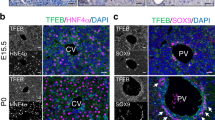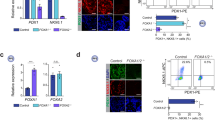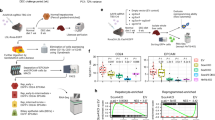Abstract
The specification of the vertebrate liver is thought to occur in a two-step process, beginning with the establishment of competence within the foregut endoderm for responding to organ-specific signals, followed by the induction of liver-specific genes. On the basis of expression and in vitro studies, it has been proposed that the Foxa transcription factors establish competence by opening compacted chromatin structures within liver-specific target genes1. Here we show that Foxa1 and Foxa2 (forkhead box proteins A1 and A2) are required in concert for hepatic specification in mouse. In embryos deficient for both genes in the foregut endoderm, no liver bud is evident and expression of the hepatoblast marker alpha-fetoprotein (Afp) is lost. Furthermore, Foxa1/Foxa2-deficient endoderm cultured in the presence of exogenous fibroblast growth factor 2 (FGF2) fails to initiate expression of the liver markers albumin and transthyretin. Thus, Foxa1 and Foxa2 are required for the establishment of competence within the foregut endoderm and the onset of hepatogenesis.
This is a preview of subscription content, access via your institution
Access options
Subscribe to this journal
Receive 51 print issues and online access
$199.00 per year
only $3.90 per issue
Buy this article
- Purchase on Springer Link
- Instant access to full article PDF
Prices may be subject to local taxes which are calculated during checkout



Similar content being viewed by others
References
Zaret, K. S. Regulatory phases of early liver development: paradigms of organogenesis. Nature Rev. Genet. 3, 499–512 (2002)
Bossard, P. & Zaret, K. S. GATA transcription factors as potentiators of gut endoderm differentiation. Development 125, 4909–4917 (1998)
Gualdi, R. et al. Hepatic specification of the gut endoderm in vitro: cell signaling and transcriptional control. Genes Dev. 10, 1670–1682 (1996)
Jung, J., Zheng, M., Goldfarb, M. & Zaret, K. S. Initiation of mammalian liver development from endoderm by fibroblast growth factors. Science 284, 1998–2003 (1999)
Bossard, P. & Zaret, K. S. Repressive and restrictive mesodermal interactions with gut endoderm: possible relation to Meckel's Diverticulum. Development 127, 4915–4923 (2000)
Costa, R. H., Grayson, D. R. & Darnell, J. E. Jr Multiple hepatocyte-enriched nuclear factors function in the regulation of transthyretin and α1-antitrypsin genes. Mol. Cell. Biol. 9, 1415–1425 (1989)
Lai, E. et al. HNF-3A, a hepatocyte-enriched transcription factor of novel structure is regulated transcriptionally. Genes Dev. 4, 1427–1436 (1990)
Lai, E., Prezioso, V. R., Tao, W. F., Chen, W. S. & Darnell, J. E. Jr Hepatocyte nuclear factor 3 alpha belongs to a gene family in mammals that is homologous to the Drosophila homeotic gene fork head. Genes Dev. 5, 416–427 (1991)
Kaestner, K. H. The hepatocyte nuclear factor 3 (HNF3 or FOXA) family in metabolism. Trends Endocrinol. Metab. 11, 281–285 (2000)
Holmqvist, P. H., Belikov, S., Zaret, K. S. & Wrange, O. FoxA1 binding to the MMTV LTR modulates chromatin structure and transcription. Exp. Cell Res. 304, 593–603 (2005)
Cirillo, L. A. & Zaret, K. S. An early developmental transcription factor complex that is more stable on nucleosome core particles than on free DNA. Mol. Cell 4, 961–969 (1999)
Cirillo, L. A. et al. Binding of the winged-helix transcription factor HNF3 to a linker histone site on the nucleosome. EMBO J. 17, 244–254 (1998)
Cirillo, L. A. et al. Opening of compacted chromatin by early developmental transcription factors HNF3 (FoxA) and GATA-4. Mol. Cell 9, 279–289 (2002)
Crowe, A. J. et al. Hepatocyte nuclear factor 3 relieves chromatin-mediated repression of the α-fetoprotein gene. J. Biol. Chem. 274, 25113–25120 (1999)
Kaestner, K. H., Katz, J., Liu, Y., Drucker, D. J. & Schutz, G. Inactivation of the winged helix transcription factor HNF3α affects glucose homeostasis and islet glucagon gene expression in vivo. Genes Dev. 13, 495–504 (1999)
Shen, W., Scearce, L. M., Brestelli, J. E., Sund, N. J. & Kaestner, K. H. Foxa3 (hepatocyte nuclear factor 3γ) is required for the regulation of hepatic GLUT2 expression and the maintenance of glucose homeostasis during a prolonged fast. J. Biol. Chem. 276, 42812–42817 (2001)
Ang, S. L. & Rossant, J. HNF-3β is essential for node and notochord formation in mouse development. Cell 78, 561–574 (1994)
Weinstein, D. C. et al. The winged-helix transcription factor HNF-3 beta is required for notochord development in the mouse embryo. Cell 78, 575–588 (1994)
Lee, C. S., Sund, N. J., Behr, R., Herrera, P. L. & Kaestner, K. H. Foxa2 is required for the differentiation of pancreatic α-cells. Dev. Biol. 278, 484–495 (2005)
Bort, R., Martinez-Barbera, J. P., Beddington, R. S. & Zaret, K. S. Hex homeobox gene-dependent tissue positioning is required for organogenesis of the ventral pancreas. Development 131, 797–806 (2004)
Deutsch, G., Jung, J., Zheng, M., Lora, J. & Zaret, K. S. A bipotential precursor population for pancreas and liver within the embryonic endoderm. Development 128, 871–881 (2001)
Keng, V. W. et al. Homeobox gene Hex is essential for onset of mouse embryonic liver development and differentiation of the monocyte lineage. Biochem. Biophys. Res. Commun. 276, 1155–1161 (2000)
Martinez Barbera, J. P. et al. The homeobox gene Hex is required in definitive endodermal tissues for normal forebrain, liver and thyroid formation. Development 127, 2433–2445 (2000)
Parviz, F. et al. Hepatocyte nuclear factor 4α controls the development of a hepatic epithelium and liver morphogenesis. Nature Genet. 34, 292–296 (2003)
Coffinier, C. et al. Bile system morphogenesis defects and liver dysfunction upon targeted deletion of HNF1β. Development 129, 1829–1838 (2002)
Clotman, F. et al. The onecut transcription factor HNF6 is required for normal development of the biliary tract. Development 129, 1819–1828 (2002)
Wilkinson, D. G. In Situ Hybridization. A Practical Approach (Oxford Univ. Press, Oxford, 1992)
Acknowledgements
We thank A. Calmont for technical help with explant culture. We are also grateful for technical support from the Morphology Core at the University of Pennsylvania. This work was supported by an award from the National Institutes of Health (NIH) to K.H.K., a Children's Digestive Health and Nutrition Foundation Young Investigator Award to J.R.F. and by training grants from the NIH to C.S.L. and J.R.F.
Author information
Authors and Affiliations
Corresponding author
Ethics declarations
Competing interests
Reprints and permissions information is available at npg.nature.com/reprintsandpermissions. The authors declare no competing financial interests.
Rights and permissions
About this article
Cite this article
Lee, C., Friedman, J., Fulmer, J. et al. The initiation of liver development is dependent on Foxa transcription factors. Nature 435, 944–947 (2005). https://doi.org/10.1038/nature03649
Received:
Accepted:
Issue Date:
DOI: https://doi.org/10.1038/nature03649
This article is cited by
-
Transcription factor-mediated direct cellular reprogramming yields cell-type specific DNA methylation signature
Scientific Reports (2023)
-
Fetal liver development and implications for liver disease pathogenesis
Nature Reviews Gastroenterology & Hepatology (2023)
-
Pioneer factors as master regulators of the epigenome and cell fate
Nature Reviews Molecular Cell Biology (2022)
-
Loss of FOXA2 induces ER stress and hepatic steatosis and alters developmental gene expression in human iPSC-derived hepatocytes
Cell Death & Disease (2022)
-
The bromodomain inhibitor JQ1 up-regulates the long non-coding RNA MALAT1 in cultured human hepatic carcinoma cells
Scientific Reports (2022)
Comments
By submitting a comment you agree to abide by our Terms and Community Guidelines. If you find something abusive or that does not comply with our terms or guidelines please flag it as inappropriate.



